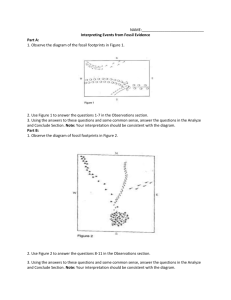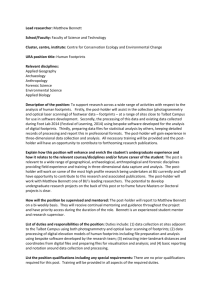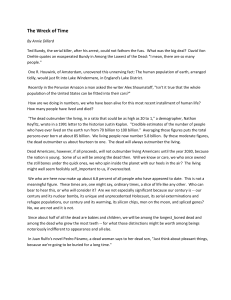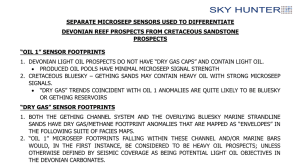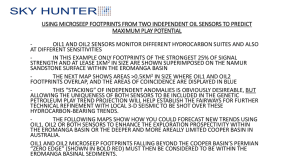- Efficient Energy Integrated Solutions for Manufacturing
advertisement
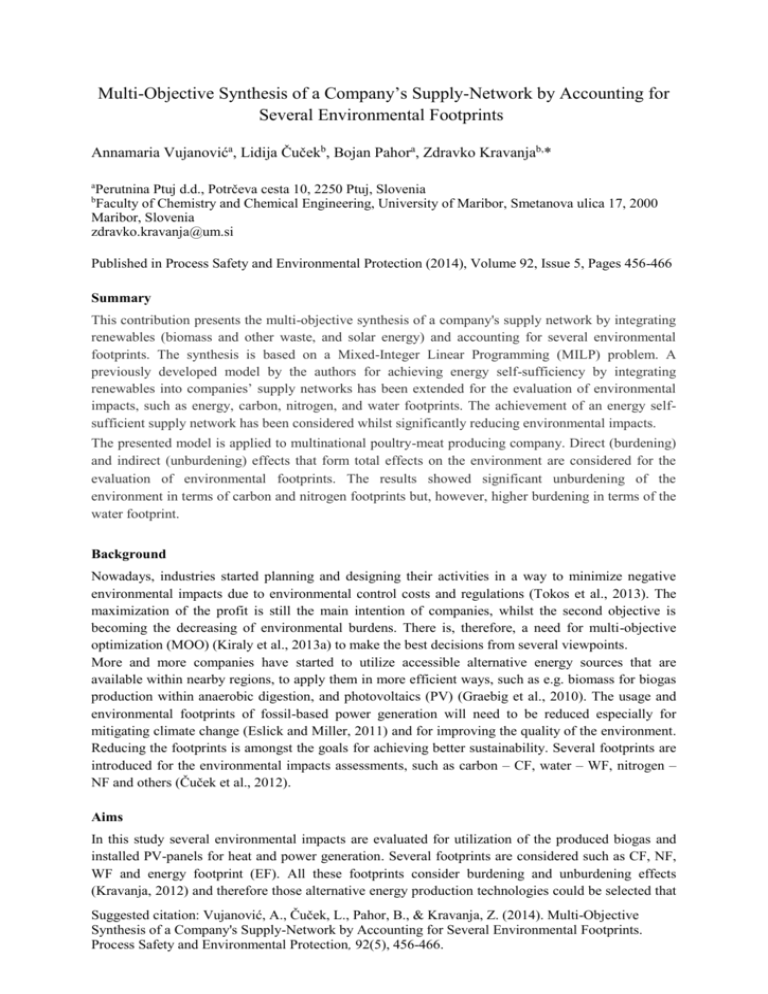
Multi-Objective Synthesis of a Company’s Supply-Network by Accounting for Several Environmental Footprints Annamaria Vujanovića, Lidija Čučekb, Bojan Pahora, Zdravko Kravanjab,* Perutnina Ptuj d.d., Potrčeva cesta 10, 2250 Ptuj, Slovenia Faculty of Chemistry and Chemical Engineering, University of Maribor, Smetanova ulica 17, 2000 Maribor, Slovenia zdravko.kravanja@um.si a b Published in Process Safety and Environmental Protection (2014), Volume 92, Issue 5, Pages 456-466 Summary This contribution presents the multi-objective synthesis of a company's supply network by integrating renewables (biomass and other waste, and solar energy) and accounting for several environmental footprints. The synthesis is based on a Mixed-Integer Linear Programming (MILP) problem. A previously developed model by the authors for achieving energy self-sufficiency by integrating renewables into companies’ supply networks has been extended for the evaluation of environmental impacts, such as energy, carbon, nitrogen, and water footprints. The achievement of an energy selfsufficient supply network has been considered whilst significantly reducing environmental impacts. The presented model is applied to multinational poultry-meat producing company. Direct (burdening) and indirect (unburdening) effects that form total effects on the environment are considered for the evaluation of environmental footprints. The results showed significant unburdening of the environment in terms of carbon and nitrogen footprints but, however, higher burdening in terms of the water footprint. Background Nowadays, industries started planning and designing their activities in a way to minimize negative environmental impacts due to environmental control costs and regulations (Tokos et al., 2013). The maximization of the profit is still the main intention of companies, whilst the second objective is becoming the decreasing of environmental burdens. There is, therefore, a need for multi-objective optimization (MOO) (Kiraly et al., 2013a) to make the best decisions from several viewpoints. More and more companies have started to utilize accessible alternative energy sources that are available within nearby regions, to apply them in more efficient ways, such as e.g. biomass for biogas production within anaerobic digestion, and photovoltaics (PV) (Graebig et al., 2010). The usage and environmental footprints of fossil-based power generation will need to be reduced especially for mitigating climate change (Eslick and Miller, 2011) and for improving the quality of the environment. Reducing the footprints is amongst the goals for achieving better sustainability. Several footprints are introduced for the environmental impacts assessments, such as carbon – CF, water – WF, nitrogen – NF and others (Čuček et al., 2012). Aims In this study several environmental impacts are evaluated for utilization of the produced biogas and installed PV-panels for heat and power generation. Several footprints are considered such as CF, NF, WF and energy footprint (EF). All these footprints consider burdening and unburdening effects (Kravanja, 2012) and therefore those alternative energy production technologies could be selected that Suggested citation: Vujanović, A., Čuček, L., Pahor, B., & Kravanja, Z. (2014). Multi-Objective Synthesis of a Company's Supply-Network by Accounting for Several Environmental Footprints. Process Safety and Environmental Protection, 92(5), 456-466. exhibit significant unburdening capabilities and have the more positive total effects. The relationships between different footprints are also investigated. The main objective of this work was to perform the multi-objective synthesis of a company’s supplynetwork by integrating renewables in order to achieve an energy self-sufficient supply-network whilst significantly reducing environmental impacts. It was applied to a large-scale food industry, the main activity of which is the producing of fresh meat and meat products. It also includes various renewable energy production possibilities, such as reusing of the manure for electricity and heat production and photovoltaic (PV) electricity production. Methods A multi-objective synthesis (MOO) of an industrial supply-network was applied to an existing largescale meat producing company. The industrial supply-network’s baseline includes one biogas plant was taken into account and upgraded by integrating the potentially available renewable energy sources within the nearby region, such as photovoltaic panels, animal and organic waste, and waste heat. The rooftop surfaces of industrial objects located at different locations were used for electricity production via PV panels. Due to the excess of accumulated manure as a side-product of the poultry industry, additional potential locations were proposed for biogas and cogeneration plants. District heating of the nearby settlements was proposed for low-grade heat produced from the additional biogas plants. For the MOO, mathematical programming approach was used based on a MILP framework. The synthesis was based on previous work by the authors (see Kiraly et al., 2013b) and had now been extended in order to evaluate several footprints (EF, CF, WF and NF) originating from the company’s supply-network and for multi-objective synthesis, where the main criterion was maximizing the economic profit and the footprints are minimized as additional criteria. It should be noted that only those footprints were accounted for that originated from the renewables’-based integrated supplynetworks (biogas and cogeneration plants, and photovoltaic panels), and from transportation. Total footprints are considered representing the sum of burdening and unburdening effects. Results 3 2.8 2.6 2.4 2.2 2 1.8 1.6 1.4 1.2 1 Relative total footprint Relative direct footprint MOO was applied to an industrial case study of an existing food industry’s network, which is spread around its surrounding regional supply-network. The economic profit, direct, total and direct/total footprints are assessed in regard to the installations of additional renewable energy-producing units. Relative direct and total footprints vs. additional energy producing units are shown in Figure 1. 3 2.75 2.5 2.25 2 1.75 1.5 1.25 1 0.75 0.5 0.25 0 -0.25 -0.5 -0.75 Additional energy-producing units Relative direct CF Relative direct WF Additional energy-producing units Relative directtotal NF CF Relative Relative total WF Relative total NF Figure 1: Relative direct and total footprints vs. additional energy-producing units Suggested citation: Vujanović, A., Čuček, L., Pahor, B., & Kravanja, Z. (2014). Multi-Objective Synthesis of a Company's Supply-Network by Accounting for Several Environmental Footprints. Process Safety and Environmental Protection, 92(5), 456-466. The relative increase in direct footprints can be seen when installing new units. However from total perspective production of renewable heat and electricity would, in general, reduce CF and WF and bring unburdening in terms of these footprints. On the other hand, total WF would increase and that would mean that the currently-used heat and electricity would have better impact on the environment in terms of WF. Figure 2 shows the effects on the environment of utilizing the renewables in terms of the relative total CF, total NF, total WF, total EF (electricity-transportation and heat). These footprints are shown in relation to the profit and newly-installed energy producing units. Certain footprints indicate that unburdening surpasses the burdening of the environment and the break-even points can be shown at zero relative total footprints. 1.045 Relative profit 1.04 FSP_PV BREED3_PV 1.035 1.03 1.025 CHP3 CHP5 1.02 1.015 CHP4 1.01 1.005 1 -1.25 CHP1 -0.75 -0.25 0.25 0.75 1.25 1.75 2.25 2.75 Relative total footprint Relative total WF Relative total ELTRF Relative total CF Relative total HF Relative total NF Figure 2: Relative profit vs. relative total footprints Acknowledgments The authors are grateful for the financial support from the European Social Fund, the Slovenian Technology Agency – TIA (PhD research fellowship contract No P-MR-10/89), the Slovenian Research Agency – ARRS (programmes P2-0032 and P2-0377), and from the EC FP7 project ENER/FP7/296003/EFENIS ‘Efficient Energy Integrated Solutions for Manufacturing Industries – EFENIS’. References Čuček, L., Klemeš, J.J., Kravanja, Z., 2012. A Review of Footprint analysis tools for monitoring impacts on sustainability. Journal of Cleaner Production 34, 9-20. Eslick, J.C., Miller, D.C., 2011. A multi-objective analysis for the retrofit of a pulverized coal power plant with a CO2 capture and compression process. Computers & Chemical Engineering 35, 14881500. Graebig, M., Bringezu, S., Fenner, R., 2010. Comparative analysis of environmental impacts of maize–biogas and photovoltaics on a land use basis. Solar Energy 84, 1255-1263. Kiraly, A., Pahor, B., Čuček L., Kravanja, Z., 2013a. Dynamic Multi-Objective Synthesis of Companies’ Renewable Biomass and Energy Supply-Networks, Chemical Engineering Transactions 35, 73-78. Kiraly, A., Pahor, B., Kravanja, Z., 2013b. Achieving Energy Self-Sufficiency by Integrating Renewables into Companies’ Supply Networks. Energy 55, 46-57. Suggested citation: Vujanović, A., Čuček, L., Pahor, B., & Kravanja, Z. (2014). Multi-Objective Synthesis of a Company's Supply-Network by Accounting for Several Environmental Footprints. Process Safety and Environmental Protection, 92(5), 456-466. Kravanja, Z., 2012. Process systems engineering as an integral part of global systems engineering by virtue of its energy — environmental nexus. Current Opinion in Chemical Engineering 1, 231-237. Tokos, H., Novak Pintarič, Z., Yang, Y., 2013. Bi-objective optimization of a water network via benchmarking. Journal of Cleaner Production 39, 168-179. Suggested citation: Vujanović, A., Čuček, L., Pahor, B., & Kravanja, Z. (2014). Multi-Objective Synthesis of a Company's Supply-Network by Accounting for Several Environmental Footprints. Process Safety and Environmental Protection, 92(5), 456-466.
